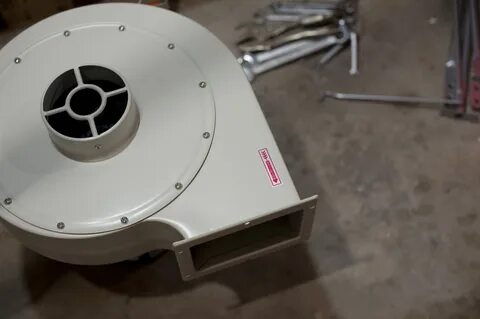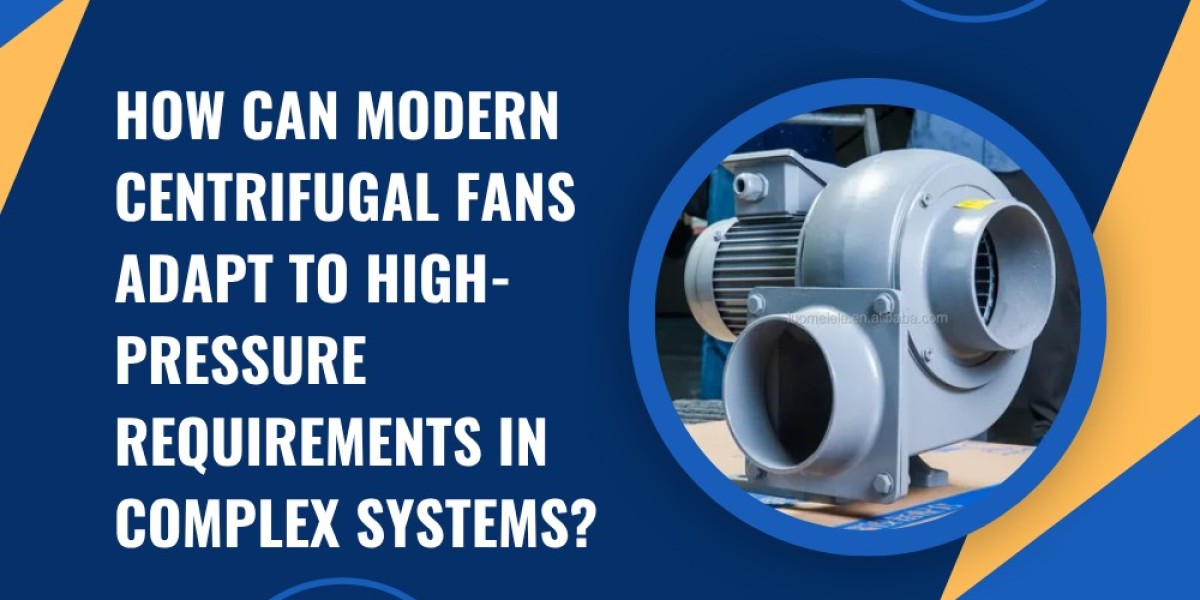Centrifugal fans are utilized in a wide range of industrial and commercial applications, including HVAC systems, cleanrooms, chemical processing, materials handling, and power generation. While in the past they were typically only suitable for low to medium pressure and flow systems, they are now required to handle much higher pressures as we push our equipment into more challenging systems. These requirements necessitate improvements in design, materials, and control techniques to fulfill them while maintaining the highest level of fan performance, efficiency, and reliability.
This article examines both the ways in which modern centrifugal fans have evolved to meet high-pressure needs and the advancements in technology that make this possible, and also considers some challenges engineers face when trying to integrate these fans into larger systems.
Understanding Centrifugal Fans and High-Pressure Requirements
Centrifugal fans, also sometimes known as blowers, operate by pulling air into the center of a rotating impeller and discharging it radially outward into the system duct. The basic idea is a very simple one, but it is difficult to build a powerful propulsion system.
High Pressure. When there is a requirement to transport air or other gases, under pressure, against some resistance, then we have high-pressure applications, which can be due to:
- Extended or Complex Duct Runs
- High-density filters or heat exchangers
- Process equipment utilizing specific air flow rates
In such conditions, centrifugal fans must be energy-efficient, stable, and durable while overcoming high backpressure.
NOTE:- Centrifugal fans in UAE were designed to enhance ventilation in commercial and industrial spaces. Airody Trading LLC supplied these fans with superior performance and long-lasting reliability. Clients reported better air quality and operational efficiency. Reach out to Airody Trading LLC now to upgrade your ventilation systems. Key Design Features for High-Pressure Performance
To meet the requirements at high pressure, numerous design improvements have been made to centrifugal fans.
Optimized Impeller Geometry
One can say that an impeller is the soul of a centrifugal fan. Today's high-pressure fans feature extremely efficient and specially optimized rotors for enhanced aerodynamic efficiency and pressure build-up. Key design adjustments include:
- BC blades: They are ideal for applications that require local resistance and where energy savings are crucial, and higher pressure capabilities must be sustained.
- More blade height or density: By using more blades or taller ones, you’re able to displace more air per rotation, producing higher pressure.
- Precision-made CNC inlet/outlet ports: Fine-tuning the blade inlet and outlet angles enhances airflow stability, thus reducing turbulence – a must in higher pressure-drop systems such as those with variable backpressure.

Robust Casing and Housing
Mechanical and thermal stress. Mechanical stress is associated with high-pressure operation. Contemporary centrifugal fans have inbuilt robust casings and are fabricated of high-strength steel, aluminum, stainless steel, or composites. These are materials that can withstand the forces at higher levels without significant deformation or loss of efficiency. Furthermore, carefully designed volutes and scroll shapes facilitate the smooth passage of air, minimising energy losses.
Advanced Motor and Drive Systems
Conventional fan motors can struggle to operate under high pressure, requiring increased torque to continue moving air. These are all solved in contemporary centrifugal fans by:
- VFDs: VFDs enable the on-the-fly tuning of fan/motor speeds, allowing for optimal adjustments of cfm and pressure based on system needs.
- High-torque motors: By adjusting the design of our motor, higher pressures can be achieved, which means that pressure drops and thus flash points can increase without additional heating.
- Direct drive vs. belt drive: Both have their own benefits in terms of efficiency, maintenance, and capacity, which can suit system requirements.
Materials and Manufacturing Advancements
Developing high-pressure centrifugal fans is also closely tied to the advancement of new materials and manufacturing processes. These enhancements guarantee durability, wear resistance, and longevity.
High-Performance Materials
Materials Today's fans are frequently blended with materials that have a low corrosion rate, do not erode or degrade under high temperatures. Popular choices include stainless steel, composites with reinforcements, and wear-resistant alloys. In chemical or abrasive applications,they prevent wear and extend pump life.
Precision Manufacturing Techniques
CAD and CNC machining enable tight tolerances, ensuring impellers and casings perform to design specifications under high pressure. From this, also consider the following data: using Additive manufacturing, we are able to (NB!) manufacture complicated porous structures that would otherwise be complex or impractical.
Control Strategies for Complex Systems
Power requirements are often high in systems involving numerous mutually interdependent components. Intelligent control is a necessary means to ensure the performance of modern centrifugal fans.
Real-Time Monitoring and Feedback
Sensors monitor vital parameters, including airflow, pressure, temperature, and vibration. Data are introduced into control systems that manipulate the speed of motors, blade pitch, or guide vanes to optimise performance. This enables fans to respond dynamically to changing system conditions without requiring human intervention.
Integration with Building Management and Industrial Control Systems
In sophisticated construction, ventilation, or industrial systems, fans are often plenum-based (duct-based). Fans may be controlled by BMS and/or PLCs to:
- Work together with other apparatus to get an imbalanced airflow.
- Use energy as efficiently as possible during both peak and off-peak periods.
- Use of operating parameters to predict maintenance requirements
Adaptive Blade and Vane Technologies
Some modern high-pressure fans have adjustable blades or guide vanes that can not only rotate about their own axis but also translate in response to the fan system. This variable flexibility permits the fan to operate with high efficiency at various pressures and flow rates.
Addressing Challenges in High-Pressure Environments
Though modern centrifugal fans have effective variations, there remain applications where engineers face difficulties in designing systems for high-pressure conditions.
Managing Noise and Vibration
High-pressure fans are noisier and vibrate more than low-pressure fans due to higher centrifugal forces and volume turbulence. Sophisticated vibration isolating systems, impeller balancing to a high level of precision, and noise barriers are typically used to address such challenges.
Energy Efficiency
It takes significantly more energy to have air moving at high pressure. In order to be sustainable and economical, modern fans include aerodynamic improvements, feedback control systems such as VFDs, and smart controls that minimize the waste of electrical consumption.
Maintenance and Reliability
Operation at high pressure causes faster wear of components. Materials and lubricants must be chosen to maximize system life, and systems should be designed for ease of inspection and maintenance. Factory Overview 0110 Maintenance improvements with predictive technology. Early problem detection. The technology has only become economically viable in the last decade or so, says Lundenberg.
Applications of High-Pressure Centrifugal Fans
Centrifugal fans of modern construction are modified for high-pressure applications in a variety of complex systems, e.g.
- Industrial applications: Chemical and pharmaceutical factories, as well as power plants, all require accurate output in the face of demanding backpressure.
- Cleanrooms and labs: require high-pressure fans to maintain air quality in controlled environments, ensuring these spaces remain free from contaminants.
- High-rise HVAC Ductwork :is long, and you end up with lots of handlers, so these Fans are required to do well, not give up!
- Aerospace and defence systems: Dedicated high-pressure fans for cooling and ventilation under severe conditions.

Future Trends in High-Pressure Fan Technology
With the increasing complexity of systems and more stringent regulations on energy efficiency, the demand for high-pressure centrifugal fans has continued to rise. Emerging trends include:
- Smart materials and coatings: The Development of materials that change in response to temperature changes or mechanical stresses may enable more enhanced performance and durability.
- Sophisticated computational simulation: Using computational fluid dynamics (CFD), designers can simulate airflow and pressure before producing the product to optimize performance.
- IoT-based predictive maintenance: A network of connected fans will be able to leverage real-time analytics to pinpoint problem areas before they fail.
- Hybrid fan designs, which combine axial and centrifugal principles, may enable high-pressure operation with low power consumption and reduced noise.
Conclusion
A modern centrifugal fan is a highly optimized piece of machinery, designed for a specific duty (in addition to being highly efficient at blowing air). These fans have today become central components of intricate industrial and commercial systems that require energy to constantly move air or gas effectively, reliably, and in response to ever-changing needs.
Applied in this way, they enable engineers and system designers to achieve high performance at high pressure while minimizing energy use, noise, and maintenance issues. With the rapid advancement of technology, centrifugal fans will continue to become increasingly equipped to handle tomorrow’s most demanding and challenging industrial applications.








